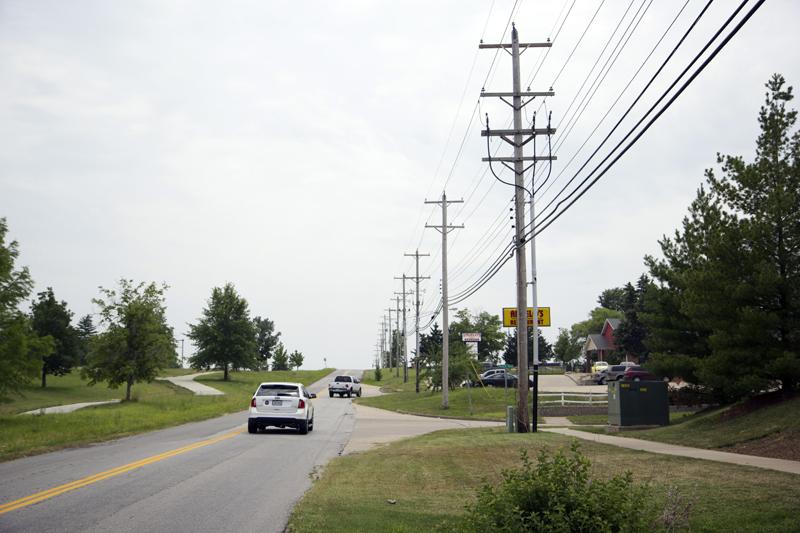
City Council will meet July 15 to vote on the placement of new transmission lines.
Sparked by a growing population and demand for reliable electricity, the long-awaited decision comes with pressure from the federal government.
There are three options up for consideration. Option A, presented in 2010, would link three substations with 161-kilovolt lines. Option B was introduced in 2011 and would use one 161-kilovolt line and two 69-kilovolt lines, taking a more circuitous route that avoids residential areas. Option B-2 came about in 2012 and follows a similar structure.
In addition, the need for a new substation, where these transmission lines will hook up, was decided several years ago and will be placed on Peach Tree Court.
Transmission lines help get electricity from power generators to homes. After the source goes through the power generator it is transferred to substations, which step down the high voltage and send it to the distribution system so customers receive power.
Despite energy efficiency programs, the percent of individual electric consumption has increased since the 1980s, but the increase of percentage per customer each year is more steady.
Columbia Water and Light staff constantly monitor the moving of electricity. The need for a higher electric capacity was first addressed in 2007.
Fifth Ward councilwoman Laura Nauser, whose area is subject to receive the lines, said there was an insufficient number of residents and impacted individuals contacted before the original proposal, Option A. She called the proposal “completely unacceptable” for a vast majority of people in her area.
Therefore, the council sent its engineering consultants back to the drawing board.
They then proposed Option B and Option B-2, which run on more city-owned property, leaving less of an impact on South Columbia property owners.
A significant difference between the choices is not using all 161-kilovolt lines but instead introducing some 69-kilovolt lines. Using 161-kilovolt lines adds 10 years of extra capacity, buying the city 30 years before having to redo the lines.
This is the equivalent of tens of millions of dollars, Second Ward councilman Michael Trapp said.
He openly supports Option A and said the council made a mistake to delay the project to create Option B and Option B-2. He joked, nicknaming Option A the engineering solution and Option B the political solution.
A recent survey by Water and Light, mailed to electric costumers, shows that residents very well understand the project’s importance but have concerns about health risks, damaging aesthetics and its affect on property value.
“All of the studies from the last 20 years have been inconclusive as far as the health risk of electromagnetic fields,” Water and Light spokeswoman Connie Kacprowicz said. “There are many things that give off EMFs, from your cellphone to your blowdryer and microwave.”
The council will also vote on placing lines underground, addressing aesthetic and property value concerns.
A benefit to putting them above ground, as far as EMFs go, is that above-ground lines have to be high up because of their voltage, farther away from a person than if they were underground, Kacprowicz said.
Putting lines above ground or underground also has a rate impact. If put overhead, electric bills will rise about $1 per month. If put underground, the increase will be about $8 per month.
This is because building the underground infrastructure is a lot more expensive — about $70 million compared to $18 million for Option A.
The cost goes toward large concrete caverns which house the lines. Since they are not in the air they do not dissipate heat very well, so the cables underground last half as long.
For Trapp, this is an area of concern.
Eight dollars doesn’t seem like much at first, but it is an extra expense, Trapp said.
“I can tell you that there is not a single person on the north side of town that wants to pay an extra $88 a year so that people on the south side of town don’t have to look at power poles,” he said.
On behalf of the people in his area, Trapp is interested in the most cost-effective, most long-ranged, perfected solution that is going to cost the least amount of money.
Despite the rate increase, 53 percent of people surveyed said they would be willing to put some lines underground.
For Nauser, the survey results do not seem representative of the individuals she has spoken with.
“A lot of people tell me they don’t want them,” she said. “Again, that is probably one of the neighborhoods that would be directly impacted. It is really hard for me to know who responded as opposed to people who contacted me personally.”
Electric and water rates will pay for repair costs without raising tax revenues. Water and Light also has a considerable amount of reserves in its budget, Nauser said.
But with project estimates as high as they are, the city might have to borrow money for construction.
“Generally, when there is large capital improvement projects that are expensive we do voter-approved bond issues,” Kacprowicz said.
The city will pay back the cost over time. Kacprowicz said this benefits residents because future users of the system help pay for the improvements, which will be around for the next 20 years.
“Electricity is something we all use and benefit from, so we all have to share the burden,” Trapp said. “It is the nature of modern day society…. Sometimes things happen that are not how you would like them to be, but it is necessary for the greater good.”
City Council has not yet set a date for construction to begin, but with federal regulatory agencies requiring the additional lines for redundancy, the city will have to act quickly to avoid being fined.